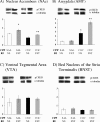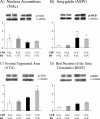cAMP response element-binding protein is required for stress but not cocaine-induced reinstatement
- PMID: 15282271
- PMCID: PMC6729724
- DOI: 10.1523/JNEUROSCI.1706-04.2004
cAMP response element-binding protein is required for stress but not cocaine-induced reinstatement
Abstract
Reinstatement of previously extinguished conditioned place preference (CPP) is precipitated by stress or drug exposure. Here, we show that acute exposure to forced swim stress (FS), in a context distinct from conditioning, induces reinstatement of cocaine CPP in wild-type mice. This behavior is accompanied by a pattern of phosphorylated cAMP response element-binding protein (pCREB) activation in discrete brain regions that is distinct from the pattern observed after cocaine-induced reinstatement. For example, previous cocaine conditioning increases pCREB levels in the amygdala, and acute exposure to FS, but not to cocaine, further augments these changes. In contrast, previous cocaine conditioning does not alter levels of pCREB in the nucleus accumbens, but acute exposure to FS increases pCREB levels in this region on reinstatement day. Furthermore, to determine whether these alterations of CREB are necessary in FS or cocaine-induced reinstatement, we examined the effect of these stimuli on reinstatement behavior in mice deficient in alpha and Delta isoforms of CREB. The CREB(alphaDelta) mutant mice show deficits in FS-induced reinstatement of conditioned place preference. In contrast, they show robust cocaine-induced reinstatement. This deficit in stress but not drug-induced reinstatement indicates a specific requirement for CREB in stress-induced behavioral responses to drugs of abuse.
Figures






Similar articles
-
Stress-induced potentiation of cocaine reward: a role for CRF R1 and CREB.Neuropsychopharmacology. 2009 Nov;34(12):2609-17. doi: 10.1038/npp.2009.91. Epub 2009 Aug 12. Neuropsychopharmacology. 2009. PMID: 19675537 Free PMC article.
-
Region-specific effects of brain corticotropin-releasing factor receptor type 1 blockade on footshock-stress- or drug-priming-induced reinstatement of morphine conditioned place preference in rats.Psychopharmacology (Berl). 2006 Mar;185(1):19-28. doi: 10.1007/s00213-005-0262-6. Epub 2005 Dec 23. Psychopharmacology (Berl). 2006. PMID: 16374599
-
Not all stress is equal: CREB is not necessary for restraint stress reinstatement of cocaine-conditioned reward.Behav Brain Res. 2013 Jun 1;246:63-8. doi: 10.1016/j.bbr.2013.02.026. Epub 2013 Mar 1. Behav Brain Res. 2013. PMID: 23458740 Free PMC article.
-
Thioredoxin-1 downregulation in the nucleus accumbens promotes methamphetamine-primed reinstatement in mice.Neuropharmacology. 2018 Sep 1;139:117-123. doi: 10.1016/j.neuropharm.2018.07.003. Epub 2018 Jul 4. Neuropharmacology. 2018. PMID: 29981334
-
NMDA antagonist MK 801 in nucleus accumbens core but not shell disrupts the restraint stress-induced reinstatement of extinguished cocaine-conditioned place preference in rats.Behav Brain Res. 2016 Dec 15;315:150-9. doi: 10.1016/j.bbr.2016.08.011. Epub 2016 Aug 6. Behav Brain Res. 2016. PMID: 27506656
Cited by
-
Cocaine-related behaviors in mice with deficient gliotransmission.Psychopharmacology (Berl). 2013 Mar;226(1):167-76. doi: 10.1007/s00213-012-2897-4. Epub 2012 Oct 27. Psychopharmacology (Berl). 2013. PMID: 23104263 Free PMC article.
-
CREB activity in dopamine D1 receptor expressing neurons regulates cocaine-induced behavioral effects.Front Behav Neurosci. 2014 Jun 11;8:212. doi: 10.3389/fnbeh.2014.00212. eCollection 2014. Front Behav Neurosci. 2014. PMID: 24966820 Free PMC article.
-
The neuropharmacology of relapse to food seeking: methodology, main findings, and comparison with relapse to drug seeking.Prog Neurobiol. 2009 Sep;89(1):18-45. doi: 10.1016/j.pneurobio.2009.05.003. Epub 2009 Jun 2. Prog Neurobiol. 2009. PMID: 19497349 Free PMC article. Review.
-
Dopamine D1 and D3 receptors are differentially involved in cue-elicited cocaine seeking.J Neurochem. 2010 Jul;114(2):530-41. doi: 10.1111/j.1471-4159.2010.06775.x. Epub 2010 Apr 28. J Neurochem. 2010. PMID: 20456009 Free PMC article.
-
Assessment of the impact of pattern of cocaine dosing schedule during conditioning and reconditioning on magnitude of cocaine CPP, extinction, and reinstatement.Psychopharmacology (Berl). 2013 May;227(1):109-16. doi: 10.1007/s00213-012-2944-1. Epub 2012 Dec 28. Psychopharmacology (Berl). 2013. PMID: 23269522 Free PMC article.
References
-
- Alheid GF, Heimer L (1988) New perspectives in basal forebrain organization of special relevance for neuropsychiatric disorders: the striatopallidal, amygdaloid, and corticopetal components of substantia innominata. Neuroscience 27: 1-39. - PubMed
-
- Bayatti N, Zschocke J, Behl C (2003) Brain region-specific neuroprotective action and signaling of corticotropin-releasing hormone in primary neurons. Endocrinology 144: 4051-4060. - PubMed
-
- Bilang-Bleuel A, Rech J, De Carli S, Holsboer F, Reul JM (2002) Forced swimming evokes a biphasic response in CREB phosphorylation in extra-hypothalamic limbic and neocortical brain structures in the rat. Eur J Neurosci 15: 1048-1060. - PubMed
-
- Carlezon Jr AW, Thome J, Olson VG, Lane-Ladd SB, Brodkin ES, Hiroi N, Duman RS, Neve RL, Nestler EJ (1998) Regulation of cocaine reward by CREB. Science 282: 2272-2275. - PubMed
-
- Cassell MD, Freedman LJ, Shi C (1999) The intrinsic organization of the central extended amygdala. Ann NY Acad Sci 877: 217-241. - PubMed
Publication types
MeSH terms
Substances
Grants and funding
LinkOut - more resources
Full Text Sources
Other Literature Sources
